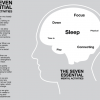I've been looking at dopamine metabolism a bit and wanted to share some of my understanding. I've bolded everything you can get readily as a supplement.
There's a nice diagram over at wikipedia that details the whole process of dopamine metabolism:
http://en.wikipedia....ical_mechanisms
Gets converted into PEA and Tyrosine. PEA is the body's natural amphetamine that is quickly degraded by MAO-B and ALDH.
- D-Phenylalanine - Synthetic D-isomer form of Phenylalanine
Only gets converted into PEA
- Tyrosine - Found in many foods
Gets converted into L-Dopa via Tyrosine Hydroxylase, the primary rate limiting enzyme in catecholamine metabolism.
Tyrosine Hydroxylase gets upregulated by nicotine and CREB activation (theoretically CILTEP)
- L-Dopa - Intermediate Product, given as a drug to treat Parkinsons. Also in Mucuna Pruriens.
Vitamin B6 as P5P is a cofactor in the conversion of L-Dopa to Dopamine
- Dopamine - Highly psychoactive compound associated largely with motivation
Gets converted to norepinephrine. A cofactor in this conversion is Vitamin C.
PDE 4 and others inhibition:
- 2x450 mg Now Artichoke Extract. Other artichoke extract brands have been reported to work too.
cAMP Increase:
- 4mg of Forskolin from uncapping and weighing out the correct proportion of Better Body Sports 95% pure C-Bolic capsules. Other forskolin supplements have been reported to work too. To get the right amount of Forskolin from a C-Bolic capsule containing 25mg of forskolin you want to multiply the weight of the emptied out material by 4/25 to get 4mg of forskolin assuming it's evenly mixed.
Dopamine Metabolism Support (Important for avoiding fatigue due to increased dopamine metabolism!):
- 500mg Phenylalanine (Lower doses work better for some)
- B-Vitamin Complex
- 200mg Caffeine (Optional)
For mitigating forskolin's effects on Acetylcholinesterase:
- 800mg ALCAR (Generally 200mg of ALCAR for every 1mg of forskolin)
An earlier recommendation before we started adding ALCAR to counteract forskolin's effects was to take the following in the afternoon:
- 350mg Jarrow N-Acetyl L-Tyrosine (Possibly no longer necessary)
I don't take this now that I've added ALCAR to the stack.
I have been taking the artichoke extract variant of this stack almost every day since late 2011 with only positive effects. There have been several attempts to replace Artichoke extract with other PDE4 inhibitors (Quercetin and/or Hesperidin) by myself and other forum users but they have not been tolerable for most people who have tried them.
These are some of the effects myself and others have reported:
- Improved mood and motivation
- Increased ability to study and retain information
- Improved long-term memory
Some people have reported nothing from taking the stack. Some users have reported tiredness after taking the stack for a while. With the later addition of dopamine metabolism supporting supplements and a forskolin dose of less than 5mg this has been less of an issue. Some users have reported diminished working memory while taking the stack, especially when taking higher does of forskolin or when taking the stack with Quercetin, which is not recommended.
Standard Disclaimer: This is a research thread. The evidence for this stack is largely theoretical and anecdotal. Proceed at your own risk, preferably after reading the whole thread. Please check with your doctor before starting a new supplement regime, especially if you have any health conditions.
Please feel free to add your comments and questions to the thread. The stack is still in active development, as you will see if you visit the later portions of the thread. The thread is a great read and contains lots of interesting scientific and anecdotal information so enjoy it. Thanks!
--- Update 4/09/2013 ---
I have been experimenting with Zembrin as a replacement for Artichoke extract. Zembrin is an extract of the plant Sceletium Tortuosum (a.k.a Kanna). Sceletium Tortuosum grows natively in South Africa and has been used in traditional medicine there for centuries. One of its components, mesembrenone, is a potent and relatively selective PDE4 inhibitor. I have only been using this stack for about a week, but so far results are good. My initial post on the thread about Zembrin is here. I have also made several follow-up posts about my experience. Artichoke Extract is a lot cheaper than Zembrin so it may be a better option for people on a budget. Myself and other users have reported good results with various other Kanna preparations which are also cheaper than Zembrin, so that may be another option. Please note that Zembrin and Kanna affect serotonin via an SSRI like effect and thus should probably not be taken by people who are currently taking SSRIs or other serotonin affecting drugs.
--- Update 6/13/2013 ---
Lately, there has been some exploration on the thread of various additions to the stack.
'Racetams that I and other forum users have anecdotally found to stack well with CILTEP: Piracetam, Phenylpiracetam.
'Racetams that forum users have anecdotally found do not stack well with CILTEP: Aniracetam
'Racetams that have provided mixed results for I and other forum users and should probably be avoided with CILTEP: Sunifiram.
Myself and other forum users have had anecdotally positive effects from adding : p5p and NADH.
Remember: Regardless of all these new developments, the basic artichoke stack still works just fine!
--- Update 6/21/2013 ---
Please note that I used Zembrin as a replacement for artichoke extract in the stack. I had some side effects when I took both together.
-- Update 6/27/2013 ---
I'm providing occasional updates and stack news at @ciltep on Twitter.
-- Update 9/10/2013 ---
Added ALCAR recommendation to the stack. Post #1 Post #2
-- Update 10/02/2013 --
I was interviewed on the smartdrugsmarts.com podcast
http://smartdrugsmar...m-potentiation/
with me is Roy Krebs of http://www.naturalstacks.com . Besides talking about the history and the mechanism of action of the stack and how awesome Longecity is we announced that we're going to be coming out this month with the first ever CILTEP all-in-one supplement!!
I've posted some comments and errata over here.
-- Update 11/24/2013 --
With regards to cycling, I take the stack every day. Some people take the weekends off or only take CILTEP when they need it. When taking days off I usually supplement with N-Acetyl-L-Tyrosine or L-Phenylalanine to avoid feeling less energetic than I would like.
If you read the thread, there are a few reports of the stack reversing tolerance to stimulants and/or increasing their effects. I would avoid taking CILTEP and stimulants like nicotine together. I haven't had any issues with reasonable amounts of caffeine though.
-- Update 03/12/2014--
There has been some discussion of various possible additions to the stack along with some experiments with D1/D2 affecting herbals. Results have been mixed.
Some have suggested that proper zinc and magnesium intake is required for optimal stack performance.














































